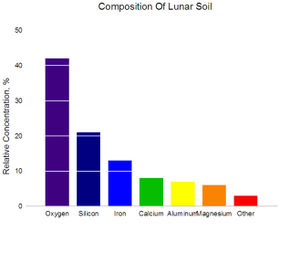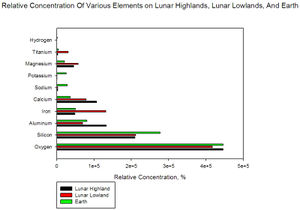Difference between revisions of "Lunar Regolith"
Jarogers2001 (talk | contribs) |
(fix spelling) |
||
| (27 intermediate revisions by 10 users not shown) | |||
| Line 1: | Line 1: | ||
| − | {{Stub}} | + | {{selene Stub}}<BR/>[[Image:658px-Moon_Comp_Graph.JPG|thumb|Relative Concentration Of Various Elements On The Lunar Surface]] |
| − | |||
| − | |||
[[Image:800px-Moon_VS_Earth_Composition.JPG|thumb|Relative Concentration (in weight ppm) of Various Elements on Lunar Highlands, Lunar Lowlands, and Earth]] | [[Image:800px-Moon_VS_Earth_Composition.JPG|thumb|Relative Concentration (in weight ppm) of Various Elements on Lunar Highlands, Lunar Lowlands, and Earth]] | ||
| − | The portion of the regolith of a size less than 1cm is generally referred to as | + | |
| + | |||
| + | The layer of debris which blankets most of the moon is commonly referred to as [[exd:Regolith|regolith<sup><b>exd</b></sup>]]. Billions of years of bombardment from space have created a highly comminuted (this means it has been broken into ever smaller grains and particles) surface through a process sometimes referred to as "impact gardening" or "space weathering." It is estimated that the regolith varies in thickness from 3 to 5 meters over the younger "maria" to approximately 10 to 20 meters thick in the older "highlands." Below the impact regolith is a layer of "mega-regolith" consisting of highly fractured bedrock that is tens of kilometers thick. | ||
| + | <BR/><BR/> | ||
| + | The portion of the regolith of a size less than 1cm is generally referred to as Lunar Soil, which is a misnomer in terrestrial geologic terms. The term "lunar soil" should not be confused with terrestrial use of the word ''soil'', and no implication of organic content is intended. When pertaining to lunar science, the terms are used interchangeably. The dusty, abrasive portion is referred to as [[Lunar Dust]] or "Fines." | ||
<BR/><BR/> | <BR/><BR/> | ||
| − | Lunar regolith is the focus of many proposed methods | + | Lunar regolith is the focus of many proposed methods of [[LUNOX | oxygen production]] and [[In Situ Resource Utilization | in-situ resource utilization]] including: |
*[[Ilmenite Reduction]] | *[[Ilmenite Reduction]] | ||
| + | *[[Fluorine reaction]] | ||
*[[Glass Reduction]] | *[[Glass Reduction]] | ||
*[[Radiation shielding]] | *[[Radiation shielding]] | ||
| − | *[[Volatile scavenging]] | + | *[[Sintered Brick Construction]] |
| + | *[[Sintered Regolith]] | ||
| + | *[[Volatile]] scavenging | ||
| + | *[[Heat Sink|Heat sink]] fluid | ||
| + | ==Related Articles== | ||
| + | *[[Geologic Processes on the Moon]] | ||
| + | *[[Lunar Dust]] | ||
==External Links== | ==External Links== | ||
| − | Lunar Soil at Wikipedia.org [http://en.wikipedia.org/wiki/Lunar_soil http://en.wikipedia.org/wiki/Lunar_soil] | + | *Lunar Soil at Wikipedia.org [http://en.wikipedia.org/wiki/Lunar_soil http://en.wikipedia.org/wiki/Lunar_soil] |
| − | PERMANENT.com [http://permanent.com/ http://permanent.com/] | + | *PERMANENT.com [http://permanent.com/ http://permanent.com/] |
| − | ISRU on the Moon. by Larry Taylor[http://www.lpi.usra.edu/lunar_knowledge/LTaylor.pdf http://www.lpi.usra.edu/lunar_knowledge/LTaylor.pdf]<BR/> | + | *ISRU on the Moon. by Larry Taylor [http://www.lpi.usra.edu/lunar_knowledge/LTaylor.pdf http://www.lpi.usra.edu/lunar_knowledge/LTaylor.pdf] (PDF)<BR/> |
[[Category:Selenology]] | [[Category:Selenology]] | ||
| + | [[Category:ISRU]] | ||
Latest revision as of 18:37, 4 June 2013
This article is a Selenological stub. You can help Lunarpedia by expanding it.
|
The layer of debris which blankets most of the moon is commonly referred to as regolithexd. Billions of years of bombardment from space have created a highly comminuted (this means it has been broken into ever smaller grains and particles) surface through a process sometimes referred to as "impact gardening" or "space weathering." It is estimated that the regolith varies in thickness from 3 to 5 meters over the younger "maria" to approximately 10 to 20 meters thick in the older "highlands." Below the impact regolith is a layer of "mega-regolith" consisting of highly fractured bedrock that is tens of kilometers thick.
The portion of the regolith of a size less than 1cm is generally referred to as Lunar Soil, which is a misnomer in terrestrial geologic terms. The term "lunar soil" should not be confused with terrestrial use of the word soil, and no implication of organic content is intended. When pertaining to lunar science, the terms are used interchangeably. The dusty, abrasive portion is referred to as Lunar Dust or "Fines."
Lunar regolith is the focus of many proposed methods of oxygen production and in-situ resource utilization including:
- Ilmenite Reduction
- Fluorine reaction
- Glass Reduction
- Radiation shielding
- Sintered Brick Construction
- Sintered Regolith
- Volatile scavenging
- Heat sink fluid
Related Articles
External Links
- Lunar Soil at Wikipedia.org http://en.wikipedia.org/wiki/Lunar_soil
- PERMANENT.com http://permanent.com/
- ISRU on the Moon. by Larry Taylor http://www.lpi.usra.edu/lunar_knowledge/LTaylor.pdf (PDF)








